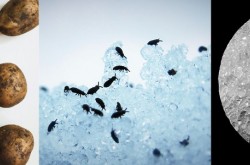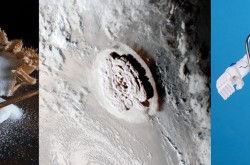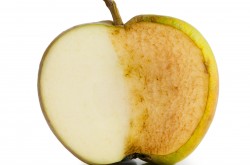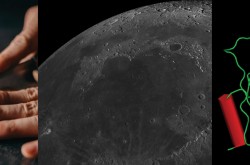2 things - and more! - you should know about plant-based milk alternatives and weather on Mars
Meet Cassandra Marion and Renée-Claude Goulet.
They are two of Ingenium’s science advisors, providing expert scientific advice on key subjects relating to the Canada Aviation and Space Museum, and the Canada Agriculture and Food Museum.
In this colourful monthly blog series, Ingenium’s science advisors offer up quirky nuggets related to their areas of expertise. For this August edition, Cassandra Marion has invited Dr. Tanya Harrison from the Outer Space Institute to fill in. Together, our experts explain how plant-based milk alternatives stack up to cow's milk, and share three interesting tidbits about weather on Mars!

How do plant-based milk alternatives stack up to cow's milk?
"Cream, milk, soy, or oat?" is a question we are used to answering in coffee shops nowadays. Options are certainly not missing when it comes to milk alternatives, but how do these stack up to cow's milk?
Milk is a nutritional powerhouse, representing a complete food. After all, it contains all the ingredients needed to grow an animal in a short amount of time: protein, fats, carbohydrates, vitamins, and minerals. With its molecular profile, it can be transformed into a slew of different products. For example, through bacterial fermentation, we get cheese, yogurt, and kefir. If we separate the different parts of milk, we can make things like powdered milk protein, butter, and whipping cream. Milk's nutrition and versatility are partly why it was featured prominently in the Canada Food Guide until the latest revision in 2019, and what made it a staple in many Canadian refrigerators. But since 2009, according to Statistics Canada, milk sales have been losing steam. This is partly attributed to environmentally-conscious consumers choosing to replace milk and milk-containing products, such as ice cream and yogurt, with options from the growing roster of plant-based alternatives that became available since then.
Up until about 2009, soy and rice beverages were pretty much the only alternatives to milk. Consumer adoption remained low, likely for flavour and sensory reasons, and for the fact that the environmental impact of our food wasn't yet top of mind. Then, around 2008, Canadians started having access to arguably tastier almond "milk," which took over sales of soy milk. More recently, oat milk has become the preferred alternative. It seems there is constantly a new milk alternative on the grocery shelves, some of the most recent additions being coconut, cashew, macadamia nut, and pea.
Maybe you have noticed that, in Canada, milk alternatives are labeled as "beverages," such as "soy beverage" or "oat beverage." In fact, legally, plant-based milk alternatives can't be labelled as "milk" in Canada, nor in the United States or Europe. Legally, according to Canada's Food and Drug Regulations (C.R.C., c. 870), milk or whole milk:
- (a) shall be the normal lacteal secretion obtained from the mammary gland of the cow, genus Bos; and
- (b) shall contain 2 μg (micrograms, or millionth of a gram) of vitamin D per 100 mL.
While plant-based alternatives for milk can be more sustainable, they are not exactly equivalent to milk in terms of nutritional, physical, and chemical properties, and, thus, may not provide expected results in cases where milk is substituted. This becomes important if we're trying to cook or bake with these alternatives. Maybe you've had the experience yourself of trying almond milk in your coffee, only to have it curdle in an unappealing mess. Or you tried replacing milk in a recipe with soy beverage, and it didn't quite turn out. This is all due to the different molecular compositions of each of these beverages, making them react differently than milk to heating, whipping, or mixing with other ingredients.
Food scientists recognize the opportunity to improve on what we have, and they are working to make plant-based alternatives with properties that more closely resemble milk, such as creaminess, foaming ability, mouthfeel, flavour, and micronutrient and protein content. And since plant "milks" don't have the same composition as milk, they don't ferment in the same way. There is still lots left to understand about how to best ferment and transform these products to give optimum results. Scientists are also pushing the boundaries of what can be used to make milk alternatives with increased sustainability. For example, the next up-and-comer is potato "milk," developed by a professor at the University of Lund in Sweden. This is touted as one of the most sustainable alternatives to milk because potatoes are easy to grow, and more of them can be grown on the same land as current milk-alternative crops such as oats, and with significantly less water than nuts, such as almonds.
Food science is really at the forefront of this wave of new products, and we surely will see more options appear and disappear from the shelves as Canadians try new things, adopt some, and let go of others. What is for sure is that there is a wind of change requiring Canada's dairy industry to adapt. It may not be a bad thing for the dairy industry to see competition from milk alternatives, thus finding itself needing to move forward with many initiatives to the increase environmental sustainability of its farming operations. That is a net positive for everyone!
So, on your next grocery trip, why not try something new? We won't know if we like it unless we try!
By Renée-Claude Goulet
3 Things You Should Know About Weather on Mars
You might be thinking, “Mars has weather?!” The answer is yes! Weather on Mars is quite dynamic and plays a factor in where we land rovers, how we plan for operating satellites in orbit, and even in selecting potential sites for future human habitats on the Red Planet. Here are three tidbits about martian weather to help you plan your future vacation:

Martian seasons in terms of solar longitude (Ls).
Winter is Coming…on Mars
July 13 marks the beginning of winter in the southern hemisphere on Mars. For scientists, the calendar on Mars is marked in terms of something called “solar longitude,” or “Ls” for short (said aloud as “L sub S”). Mars’ orbit around the Sun is broken down into a 360° ellipse, with every 90° marking a seasonal change.
Changes in season result in changes in weather, surface temperature, and even the distribution of ice on the planet’s surface. In winter, the southern polar cap expands dramatically, extending as far north as ~20°S latitude. On Earth, that would be like the ice cover of Antarctica extending all the way to Rio De Janeiro! Instead of thick ice sheets however, this expansion is made of a mix of water ice frost and carbon dioxide frost. Frigid winter temperatures cause water vapour and carbon dioxide gas to condense out of the atmosphere and onto the surface as frost. This happens as the southernmost regions of Mars slip onto the night side of the planet, out of view until early springtime. The warming temperatures of spring cause the “seasonal” (frost) part of the cap to recede, until summer arrives and only the “residual” cap—the thick ice at the pole—remains. As the cap recedes, dust storms swirl around the retreating edge due to the temperature difference between the frost-covered and frost-free ground. Which brings us to our next thing you should know…

This movie shows the southern high-latitude region of Mars from March 19 (Ls 230) through April 14 (Ls 246), 2009, a period when regional dust storms occurred along the retreating edge of carbon-dioxide frost in the seasonal south polar cap.
Science Fiction Gets Global Dust Storms on Mars Wrong
If you’ve seen “The Martian,” you’ll know the movie kicks off with a dramatic dust storm that results in astronaut Mark Watney being stranded as his crewmates blast off to safety. The storm puts their rocket in danger of tipping over, and even manages to blow an antenna with such force that it impales poor Watney through his spacesuit.
Unfortunately (or maybe fortunately for future real astronauts?), this is science fiction.
The atmospheric pressure at the surface of Mars is less than 1 percent of the surface pressure at sea level on Earth. It’s roughly equivalent to being at 39,500 metres (130,000 feet) in elevation here, much higher than any commercial jets can fly. This means that there’s not much “oompf” behind the wind there. The danger posed is not so much from the wind, but from the extremely fine dust particles that wind lofts into the air. This abrasive dust poses hazards to sensitive equipment, and can block enough sunlight to cause issues for solar-powered rovers and landers. Opportunity, the longest-lived rover on Mars to date, was lost after nearly 15 years of operations due to the largest dust storm ever observed on the Red Planet. Dust collecting on the solar panels of NASA’s InSight lander also led to its eventual demise near the end of 2022 after four years of successful operations.

Overheard view of the Spirit rover showing its dusty solar panels in October 2007, and its clean panels thanks to dust devils in November 2008.
On Mars, Dust Devils Are Our Friends
Dust that gets thrown into the air from dust storms eventually falls down to the surface, like snow sinking in a shaken snow globe. This means some of it ends up on the solar panels, reducing the amount of sunlight that reaches them to charge up the rover/lander batteries. Where dust storms are the bane of a Mars rover’s existence, dust devils on the other hand can be their salvation! These small whirlwinds, formed when there is a strong temperature difference between the ground and the air right above it, sometimes pass over the rovers/landers and clean off dust in the process. We have dust devils to thank in part for the longevity of rovers like Spirit and Opportunity, both of which lasted many years longer than their planned 90-sol (Martian day) missions!
If you want to see what a year of weather on Mars looks like, check out this video made from images from the Mars Color Imager (MARCI) aboard NASA’s Mars Reconnaissance Orbiter: https://www.youtube.com/watch?v=MlHEHfPvwj4
By Dr. Tanya Harrison
Enjoying the Ingenium Channel? Help us improve your experience with a short survey!







































